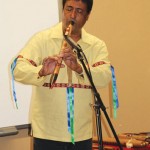An Initiative Heading to the Fall Ballot Would Require Labeling Genetically Modified Foods
By Anna Minard, Seattle Stranger
I’m wandering the aisles of Central Co-op, a natural foods market on Capitol Hill, checking its shelves for genetically engineered foods. Once you know what to look for, it turns out those ingredients are everywhere—even here, among the fake meats and packages covered in leafy art, smiling animals, and hand-lettering. They’re in the whole-grain bread, in the veggie burgers, in the peanut-free soy nut butter. You can’t always tell from friendly labels—”100% natural,” “multi-grain,” “fair trade.” But you may be able to tell soon.
Washington State will be voting in November on Initiative 522, which would require food made with genetically engineered ingredients (also known as genetically modified organisms, or GMOs) to be labeled as such at the retail level.
When I set out to research the initiative, I thought I’d end up with a clear and obvious answer about how I felt about it—and what the science says. I was wrong.
I was raised on organic produce, bulk-bin grains, and peanut butter you had to crank by hand; these food-labeling people are my people. But I still wanted to see hard science that backs up the squick factor of vegetables birthed in a petri dish. I wanted studies I could point to, something I could wave around and say, “Here! Here is incontrovertible proof that GMOs are evil! Their curse will last for generations and our grandkids will have four noses, and here, have some organic hummus.” But the smoking gun just isn’t there. Not that the anti-labeling side is all that convincing, either.
Genetically engineered food crops have been around since the 1990s, and they took off rapidly across the United States. Now certain American crops are almost universally GMO: more than 90 percent of soy and sugar beets, and 88 percent of corn, according to the US Department of Agriculture. Modifications are done at the genetic level (mainly by corporations that don’t exactly inspire trust, like Monsanto and Dow Chemical), often to make a crop resistant to a particular pest or herbicide. The FDA regularly approves new GMO plants—and soon, an animal: GMO salmon are on their way.
GMOs aren’t just in the processed food you grab in a stoned midnight run to Safeway. And while a 100 percent organic product can’t contain GMOs, lots of foods we think of as “natural” can and do.
For example, Gardenburger’s package is stamped with a cartoon cow and chicken embracing, and the message “There are no unimportant ingredients. If it’s in here, then it’s got a role to play.” That includes corn- and soy-based ingredients (and remember that nearly all US corn and soy is GMO), and when we e-mailed their parent company, the automated response we got back said that some of their products “do contain biotech ingredients.” In a form letter, the company explained: “It has become increasingly difficult to maintain non-biotech sourcing of the soy proteins.”
Franz Family Bakeries offers a “100% Natural, 100% Whole Grain” loaf of bread, touting its “premium Northwest grown & milled ingredients” and lack of high-fructose corn syrup. We asked Franz about GMOs in their bread, and they “do use cornmeal, soybean oil and canola oil in our products, and most of the corn, soybeans, and sources of canola oil are GMO, so most certainly these ingredients would be genetically modified.”
Even the crazily named I.M. Healthy Chunky SoyNut Butter, which announces on the label that it contains non-GMO soybeans, doesn’t guarantee that other ingredients in the same jar, such as corn-derived maltodextrin, aren’t genetically engineered. And the boxed gluten-free cake mix from Cherrybrook Kitchen contains some ingredients that “are not GMO-free,” the company says.
This isn’t to pick on these companies at all, or the groovy grocers that carry them; it’s just to point out how ubiquitous GMO ingredients are. And if I-522 passes this fall, we’ll be reminded wherever we shop how common they’ve become. Or, on the other hand, the measure could prompt more food producers to eradicate GMOs from their ingredients to avoid the GMO label altogether.
A vast majority of the American public supports labeling foods with GMO ingredients. A 2010 NPR/Thomson Reuters poll found that 93 percent of Americans were on board. Worldwide, more than 60 countries already label foods with GMO ingredients, including members of the European Union, China, Japan, and India.
Still, the opposition to labeling is fierce. In November, Proposition 37, which would’ve mandated labeling of GMO foods, lost on the California ballot after the opposition dumped more than $45 million into a campaign arguing that labeling GMOs would be deceptive, pointless, and expensive. The donor list looked like exactly what you’d expect: Monsanto, Dow AgroSciences, BASF Plant Science, Kraft Foods Global, Nestlé USA, ConAgra Foods.
Here in Washington, there’s already opposition to I-522. The Seattle Times came out strongly against it, saying that “there is no reliable evidence crops containing genetically modified organisms… pose any risks.” The Washington Association of Wheat Growers is opposed as well, saying that mandatory labeling of GMO foods “that are indistinguishable from foods produced through traditional methods would mislead consumers by falsely implying differences where none exist.”
When it comes to the science, people on each side promise they can debunk anything the other side claims to prove. Biotech researcher Dr. Martina Newell-McGloughlin gave compelling testimony at an I-522 hearing in Olympia, saying, “There is practically no domesticated plant or animal today that has not been genetically engineered over the last 10,000 years,” since we’ve been selectively breeding, grafting, and even irradiating foods forever. Today’s precise genetic engineering has been found by all major science and health organizations to be “as safe or safer than” conventional methods, she said. Further, she argued, GMO foods are actually “more thoroughly tested than any in the history of food,” subjected to years of research before they make it to market.
But George Kimbrell of the Center for Food Safety, who helped draft I-522, says, “We’re essentially taking the science from the industry for safety,” because the FDA doesn’t do its own pre-market testing, instead signing off on testing done by Monsanto and other companies developing the biotech foods. Dr. Michael Hansen testified in favor of I-522 in Olympia; he works for Consumers Union, the public policy arm of Consumer Reports, and he points to his organization’s long-standing position in favor of mandatory pre-market testing as opposed to the current system of “voluntary safety consultations,” as Consumers Union describes it. In place of that, Hansen says, they support labeling so consumers can at least make informed choices.
Another commonly heard argument is that labeling would burden manufacturers and grocery stores. But initiative spokeswoman Trudy Bialic, who works for PCC Natural Markets, which is running the I-522 campaign, says that’s bogus. GMO labeling would be “no different from any of the other things we keep track of already,” she says. “It did not cost us to add country of origin labeling, it did not make food unaffordable when we added nutrition panels, [and] it did not create a lot of extra costs when we started labeling trans fats.”
I-522 is also written differently than Prop 37. It specifies who’s required to do the labeling—the manufacturers—whereas Prop 37 didn’t. And Prop 37 was roundly criticized as being catnip for tort lawyers, who could claim damages from companies that didn’t properly label. In Washington, I-522 doesn’t allow awards for damages, just a reimbursement of attorney’s fees. Kimbrell says it was “deliberately drafted narrowly” to disincentivize costly lawsuits.
In the end, a lot of this comes down to how hard the food-industry opposition is willing to fight I-522. And weirdly, it turns out that buying some of the hippie products at the co-op may still be supporting the GMO industry. In California, big food companies poured money into the anti-labeling campaign, leaving labeling supporters furious. Angry green websites called for boycotts of GMO-free Silk soy milk (owned by Dean Foods), Kashi cereals (owned by Kellogg’s), Odwalla juice (owned by Coca-Cola), and tons more, since all those larger parent companies wrote checks to fight labeling. Here, as of yet, no counter-campaign to I-522 has filed with the state. ![]()
Additional reporting by Ben Steiner.












